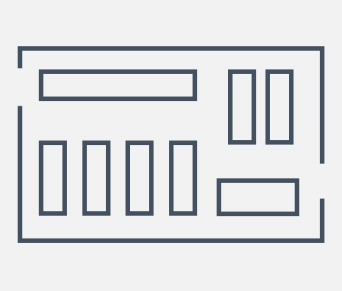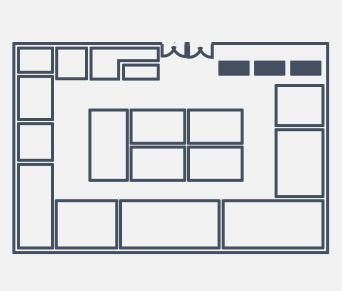Our Articles

Understanding Stages & Outputs of Retail Design
It all starts with a notion, an idea, a seed. Retail building design, much like any other type of design, begins with a concept of a retail space and then builds on this concept in a series of stages, delivering various outputs along the way, such as retail drawings, retail 3D modelling, retail rendering, etc. Let’s understand what these stages are and what we can expect to see at each one.
Though it is important to understand the stages and output of retail design, architects and retailers must first fix on the type of floor plan that works for them.
Retail stores use different types of retail store layouts. The retail industry type will determine the store layout that is required. For example, supermarkets typically use grid layouts because they are easy to remember and easy to navigate. Fashion, garment and accessory stores tend to favour more creative layouts to showcase different products.
Retail Store Layout Types

Loop Floor Plans
Optimum use of wall space and guide shoppers through a set path, e.g. clothing, accessories, homeware, toiletries, specialty stores


Free-flow Floor Plans
For specialty and boutique spaces, e.g. clothing, toiletries, specialty brands, mixed-use stores.
Diagonal Floor Plans


Forced-path Floor Plans
Angular Floor Plans

Retail store layout determines product placement, guides customer traffic and sets the tone of the retail space, so it merits careful consideration. A slew of factors may affect the choice of floor layout, such as the size and shape of the retail space, product types and even potential customers. So, each of the retail design stages must be carefully considered.
Broadly speaking, retail design follows these stages:
Concept Design
Retail design begins with a concept which is developed into a design, and thus, it begins at the Concept Stage. Concept design sees architects think about the form of a building while expressing the initial idea of a retail building. The guiding concept and design intent begin their waltz at this point. The music slows and speeds while information on requirements are gathered and hand-made drawings and sketches are created, also known as concept design drafting when they are created digitally.
 It all starts with a notion, an idea, a seed. Retail building design, much like any other type of design, commences with a concept of a retail space and then progresses through a series of stages, incorporating detailed retail drawings, intricate retail 3D modelling, and captivating retail rendering, producing a range of outputs at each step of the process./>
It all starts with a notion, an idea, a seed. Retail building design, much like any other type of design, commences with a concept of a retail space and then progresses through a series of stages, incorporating detailed retail drawings, intricate retail 3D modelling, and captivating retail rendering, producing a range of outputs at each step of the process./>
Also provided is an outline cost estimate for each retail design option. Modifications can be made to the selected retail design and will be refined in the next stage. Other deliverables that can be created using AutoCAD Architecture, Revit Architecture, ArchiCAD and BIM 360 Design for cloud collaboration at this stage include:
The Concept Design waltz glides on for some time, as there is a regular, ongoing, repeated back-and-forth between the architect and the retailer on ideas, details, dimensions, materials, space, functionality of spaces, lighting, etc.
Design Development
This stage follows the Concept Design stage. At this point, retail design is revised with the requested modifications and defined in more detail through drawings, with a range of options and 3D visualisation. Cost estimates are updated to incorporate any changes made to the initial design, and the design details are finalised. Retail space layouts, spatial arrangements, facade options, plan updates, general exterior and interior appearance, choice of construction materials and finishes are more clearly defined. The bill of quantities and cost data are calculated. Other deliverables that can be created using AutoCAD Architecture, Revit Architecture, ArchiCAD and BIM 360 Design for cloud collaboration at this stage include:
The music of the waltz hasn’t stopped yet, but it’s building up to a certain crescendo. The project stakeholders are cruising to a definite rhythm, understanding each requirements and falling in step.
Construction Documentation
Immediately after the Design Development Stage, it is at this point that the design is finalised and the final drawings for construction are prepared, which includes the development of the finalised 3D models, 2D drawings, notes, technical specifications, including plans, elevations and sections. Typically, schedules are included for costing purposes, bidding, construction and permit applications. Drawings created at this stage will integrate the work of other specialist consultants, with further detailed drawings, specifications and schedules which clearly define the quality and quantity of materials and finishes. These drawings have also been called CD Sets (Construction Documentation Sets) or GFC (Good for Construction) drawings and can be used by contractors. Construction documentation includes a vast number of clash-free drawings and documents created using the software mentioned above and Navisworks, such as:
Intelligent Revit BIM (Building Information Modelling) models can ensure that any changes to schedules, plans, elevations, sections or the 3D model itself result in coordinated updates to all corresponding areas, known as ‘integrated bi-directional associativity’. Using BIM technology results in streamlined design implementation while facilitating collaboration and information exchange between project stakeholders. Special deliverables made possible by using BIM are:
Visualisation, especially in the form of retail rendering, can be created during any stage of the retail design process. Rendered images can be created using 3ds Max, Photoshop, Illustrator, SketchUp AutoCAD and Revit Architecture. Revit Architecture can also help create material take-offs, interference checks and improved compatibility with other visualisation tools, such as 3ds Max.
Retail rendering contributes significantly to sales and marketing initiatives, make an effective communication tool for internal design approvals and reviews during the conceptualisation and design phases and can include conceptual images, 360˚ views and photorealistic perspectives of retail spaces.
Specific retail rendering services include:
Detailed 3D floor plans and models in Revit, AutoCAD or SketchUp, using plans, elevations and dimension information can be created as part of retail rendering. The 3D model is then exported to 3ds Max, where textures, materials, reflection, depth, lighting and other features are added. To add more life to the physical model, content, landscaping, vehicles and physical life elements are added using Photoshop. Plug-ins, such as V-Ray and Mental Ray, can help finish images with the required photorealistic effect.
To know more about retail design.
It’s clear that retail space planning and retail store building design have many facets. The diverse requirements and output required may not always be easily obtainable. Retail building design support may need to be outsourced to reliable partners who will have the expertise to deliver high-quality retail drawings, retail 3D modelling, retail construction drawings and retail rendering.
XS CAD has valuable experience providing retail building design services and retail space planning drawings for engineers, architects and retailers. Our range of services for structural, architectural and building engineering firms, such as consultants and contractors across the world, include retail store building design, retail drawings, retail 3D modelling, retail construction drawings and retail rendering. We have proven to be a preferred BIM outsourcing partner, due to the high quality of our 3D models and retail drawings, created by using Revit, AutoCAD, Inventor and BIM 360 Design for cloud collaboration.

